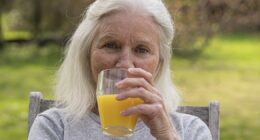A moment that changed me: ‘as I recovered from spinal surgery, the death of Princess Diana made me value life’

At 19, I had an operation that left me in a back brace for a year. But as I lay confined to bed, I realised that I had much to be grateful for
During a family holiday in 1996, my mum noticed something wasn’t quite right with my back. Sunbathing by the pool, she saw a flap of skin that looked out of place. When we got home, Dad’s osteopath traced an S-shape with her finger along my spine, and suggested I see a faith healer. Mum insisted on a more traditional route, and at the Royal National Orthopaedic hospital in Harrow, west London, I was diagnosed with scoliosis – curvature of the spine – and told I would need surgery to correct it.
I had other ideas. I was an excitable 18-year-old, determined to see the world, and even more determined not to let anything get in the way of my first year at university. I postponed surgery and went to Manchester to study management, hoping that nightly back exercises in between trips to the union bar would see me through.
Not surprisingly, my spine did not bend to my will. A year later, another X-ray revealed that things had become worse. My spine was now rotating, pushing my ribcage against my heart. Everyone looked horrified when I confessed that I had been experiencing chest pains. I could no longer avoid surgery.

My case was severe and I had anterior and posterior surgery. Part one (anterior) involved making an incision on the side of my chest, deflating a lung and removing part of a rib. Part two (posterior), a week later, involved making an incision down the middle of my back. Connection points for rods were established, then attached to my spine with screws – holding the bones in a good position to grow together. My removed rib was ground up and used as graft material for fusion. I woke up in the high-dependency unit and felt as if I was lying on concrete.
Timing, they say, is everything. I came round to the news that Diana, Princess of Wales was dead and, as I was unable to do much else, was glued to the coverage. Feelings of self-pity for a lost summer spent in a back brace disappeared as I realised I had been given a new lease of life just as Diana’s had been cut short at 36.
READ RELATED: The 41 Best Anniversary Gifts by Year for Any Couple
I didn’t know where to start but knew a career in management was now off the table. A seminar on the 1980s miners’ strike, however, planted a crucial seed of interest in how policy affects lives. Yet nothing was fully formulated in my mind. I was eager but directionless, so after graduation I went to Japan to teach English for two years. It was there that I discovered the concept of ikigai – purpose. It is the convergence of what you love, what you are good at, what you can be paid for and what the world needs.

On my return to the UK, I did an MA in international policy analysis and took a job as a policy researcher for an international development organisation. Travelling the world, I heard the same refrain wherever I went: male violence against women and girls, perpetrated by husbands, fathers, brothers. One day, talking to women at a refuge, I made the connection between women’s safety, access to money and how many victims are coerced into spending their life-savings or racking up huge debts that they spend decades paying back. This injustice – the thwarting of a woman’s ability to reach her potential – fuelled something in me. I had found my purpose.
In 2017, I set up Surviving Economic Abuse (SEA) – the country’s only charity dedicated to this form of coercive control, something one in six women will experience. We have since changed the law, successfully lobbying for economic abuse to be recognised in the Domestic Abuse Act (2021), alongside an amendment to criminalise post-separation abuse. SEA works with the UK’s biggest banks to make victim-survivors safer.
This month, I am walking the Heart of England Way, through the Midlands, to raise money for the hospital that saved my life, and after keeping it quiet from colleagues and friends, have started to share the story of my surgery. Consequently, I have had to revisit that time and acknowledge what I went through. I have been looking back at my 19-year-old self, fiercely trying to resist the reality of my body and determined not to be defined by it. Now, 25 years later, I realise I’m precisely where I am – and who I am – because of my surgery, not in spite of it.
I always knew that the surgery would be life-changing; without it I would be using a wheelchair, possibly not even alive. But I could never have imagined how realigning my spine would change the entire shape – and focus – of my life’s work. Watching the television reports of the untimely death of Diana while I recovered propelled me in a new direction. I didn’t waste my second chance to find a purpose.
Source: Health & wellbeing | The Guardian









